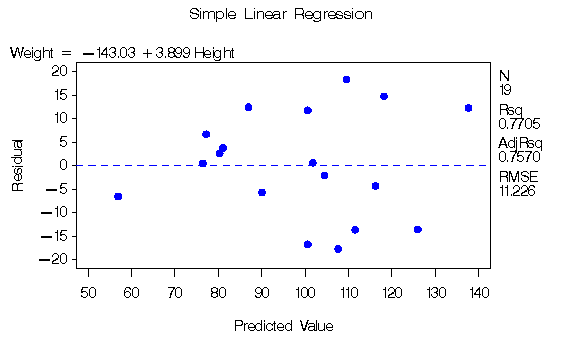Chapter Contents
Previous
Next
|
Chapter Contents |
Previous |
Next |
| The REG Procedure |
Suppose that a response variable Y can be predicted by a
linear function of a regressor variable X.
You can estimate ![]() , the intercept, and
, the intercept, and ![]() ,
the slope, in
,
the slope, in

for the observations i = 1,2, ... ,n. Fitting this model with the REG procedure requires only the following MODEL statement, where y is the outcome variable and x is the regressor variable.
proc reg;
model y=x;
run;
For example, you might use regression analysis to find out how well you can predict a child's weight if you know that child's height. The following data are from a study of nineteen children. Height and weight are measured for each child.
title 'Simple Linear Regression';
data Class;
input Name $ Height Weight Age @@;
datalines;
Alfred 69.0 112.5 14 Alice 56.5 84.0 13 Barbara 65.3 98.0 13
Carol 62.8 102.5 14 Henry 63.5 102.5 14 James 57.3 83.0 12
Jane 59.8 84.5 12 Janet 62.5 112.5 15 Jeffrey 62.5 84.0 13
John 59.0 99.5 12 Joyce 51.3 50.5 11 Judy 64.3 90.0 14
Louise 56.3 77.0 12 Mary 66.5 112.0 15 Philip 72.0 150.0 16
Robert 64.8 128.0 12 Ronald 67.0 133.0 15 Thomas 57.5 85.0 11
William 66.5 112.0 15
;
The equation of interest is

The variable Weight is the response or dependent variable in this equation, and
![]() and
and ![]() are the unknown parameters to be estimated.
The variable Height is the regressor or independent variable, and
are the unknown parameters to be estimated.
The variable Height is the regressor or independent variable, and ![]() is the unknown error.
The following commands invoke the REG procedure and fit this
model to the data.
is the unknown error.
The following commands invoke the REG procedure and fit this
model to the data.
proc reg;
model Weight = Height;
run;
Figure 55.1 includes some information concerning model fit.
The F statistic for the overall model is highly significant (F=57.076, p<0.0001), indicating that the model explains a significant portion of the variation in the data.
The degrees of freedom can be used in checking
accuracy of the data and model. The model degrees of freedom
are one less than the number of parameters to be estimated.
This model estimates two parameters, ![]() and
and ![]() ;thus, the degrees of freedom should be 2-1=1.
The corrected
total degrees of freedom are always one less than the total number
of observations in the data set, in this case 19-1=18.
;thus, the degrees of freedom should be 2-1=1.
The corrected
total degrees of freedom are always one less than the total number
of observations in the data set, in this case 19-1=18.
Several simple statistics follow the ANOVA table. The Root MSE is an estimate of the standard deviation of the error term. The coefficient of variation, or Coeff Var, is a unitless expression of the variation in the data. The R-Square and Adj R-Square are two statistics used in assessing the fit of the model; values close to 1 indicate a better fit. The R-Square of 0.77 indicates that Height accounts for 77% of the variation in Weight.
The "Parameter Estimates" table shown in Figure 55.2
contains the estimates of ![]() and
and ![]() .The table also contains the t statistics and the
corresponding p-values for testing whether
each parameter is significantly different from zero.
The p-values (t=-4.432, p=0.0004 and t=7.555, p<0.0001)
indicate that the intercept and Height
parameter estimates, respectively, are highly significant.
.The table also contains the t statistics and the
corresponding p-values for testing whether
each parameter is significantly different from zero.
The p-values (t=-4.432, p=0.0004 and t=7.555, p<0.0001)
indicate that the intercept and Height
parameter estimates, respectively, are highly significant.
| ||||||||||||||||||||||||||||
From the parameter estimates, the fitted model is
The REG procedure can be used interactively. After you specify a model with the MODEL statement and submit the PROC REG statements, you can submit further statements without reinvoking the procedure. The following command can now be issued to request a plot of the residual versus the predicted values, as shown in Figure 55.3.
plot r.*p.; run;

|
A trend in the residuals would indicate nonconstant variance in the data. Figure 55.3 may indicate a slight trend in the residuals; they appear to increase slightly as the predicted values increase. A fan-shaped trend may indicate the need for a variance-stabilizing transformation. A curved trend (such as a semi-circle) may indicate the need for a quadratic term in the model. Since these residuals have no apparent trend, the analysis is considered to be acceptable.
|
Chapter Contents |
Previous |
Next |
Top |
Copyright © 1999 by SAS Institute Inc., Cary, NC, USA. All rights reserved.